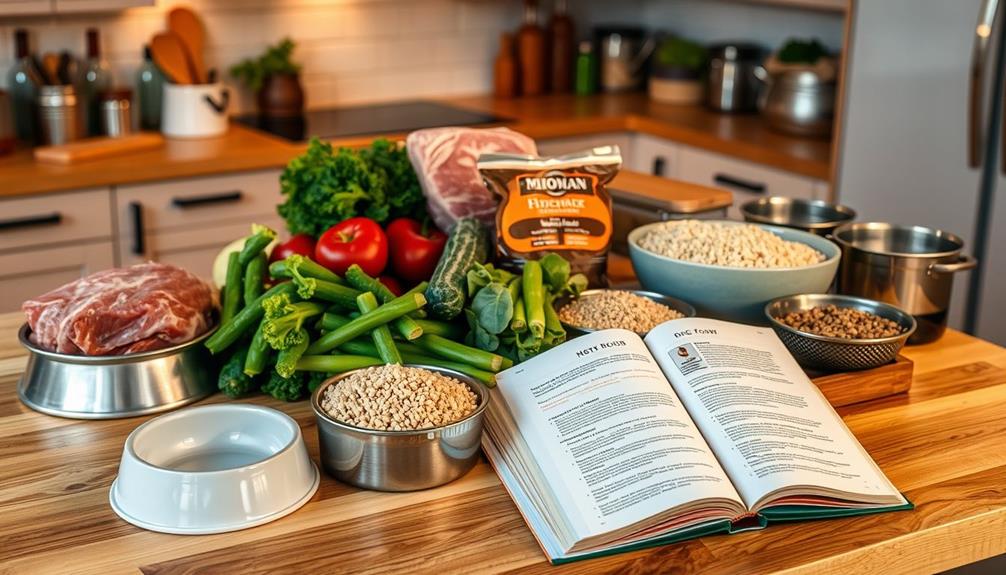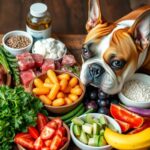A raw food diet can be your best bet for managing your overweight pet's health. It emphasizes high-quality proteins while keeping carbohydrates low, which helps in weight loss. By including lean meats like chicken or rabbit and fiber-rich veggies like broccoli, you're promoting satiety with fewer calories. The diet not only supports healthy weight management but also maintains muscle mass. Remember to shift gradually to avoid digestive upset and monitor your pet's weight regularly. If you want to explore more about raw food benefits and suitable options, you might discover valuable tips and guidance.
Key Takeaways
- A raw food diet provides high-quality protein and low carbohydrates, promoting weight loss in overweight pets.
- Lean protein sources like chicken and rabbit are essential for maintaining muscle while losing fat.
- Incorporating high-fiber vegetables, such as broccoli and pumpkin, can help pets feel fuller with fewer calories.
- Gradually transitioning to a raw diet over 10 days minimizes digestive upset and supports weight management.
- Regularly monitor weight and adjust feeding amounts to achieve a target weight loss of 2-4% per week.
Importance of Weight Management

Maintaining a healthy weight for your pet is vital, as nearly 50% of dogs are overweight. This condition can lead to serious health issues, reducing their lifespan by up to 2.5 years.
Effective weight management involves regular assessments of your dog's body condition, such as checking for visible waists and feeling ribs. These practices help you monitor their progress toward achieving their ideal weight.
To support your overweight dog, aim for a calorie deficit, which means their calorie intake should be less than the calories they burn. A balanced raw food diet can play an important role in this process. Incorporating high-quality protein and practicing portion control guarantees your pet gets the nutrients they need while managing their weight effectively.
Set a safe weight loss goal, targeting a reduction of 1-2% of their body weight per week. This gradual approach minimizes stress on their system and promotes sustainable weight loss.
Health Risks of Pet Obesity

The alarming reality of pet obesity can greatly shorten your furry friend's life, with overweight dogs potentially living up to 2.5 years less than their healthier peers. The health risks associated with obesity are significant and can severely affect their quality of life.
Common issues include arthritis, diabetes, and respiratory diseases, all of which can lead to a more sedentary lifestyle and less joy in their daily activities. Engaging your pet in active play with toys that promote physical activity can be important in combating these weight issues, as educational and skill-building toys can also enhance their overall well-being.
When your dog is overweight, you might notice symptoms like tiredness and reluctance to play, which can further exacerbate chronic inflammation and metabolic disorders. These conditions not only impact your pet's well-being but can also increase veterinary costs over time.
With approximately 50% of dogs classified as overweight, it's essential to address this issue promptly.
A proper dog diet is important for encouraging weight loss and mitigating health risks. By focusing on nutritious, balanced meals and regular exercise, you can help your furry companion regain their health and liveliness.
Prioritizing your pet's weight management today can lead to a longer, happier life for them tomorrow.
Nutritional Needs for Weight Loss

To help your overweight pet shed those extra pounds, focusing on their nutritional needs is essential. A balanced raw diet should incorporate high-quality protein, making up 30-50% of their total caloric intake. This preserves lean muscle mass while promoting weight loss.
Aim to reduce carbohydrate content to less than 10% of total calories, as high-carb foods can contribute to obesity. It's also beneficial to evaluate options like best dog food for overweight dogs that are formulated specifically for weight management.
Incorporate lean protein options like pure chicken or pure rabbit, which provide necessary nutrients while helping manage weight effectively. Adding high-fiber vegetables such as broccoli and pumpkin can promote satiety without excessive calories, supporting your pet's digestive health.
Regularly monitor adjustments based on your pet's weight and activity level, aiming for a safe weight loss rate of 2-4% of body weight per week. This approach guarantees ideal health outcomes while achieving weight loss goals.
Benefits of a Raw Food Diet

A raw food diet offers numerous benefits for overweight pets, making it an appealing option for pet owners looking to improve their furry friends' health.
By switching to a raw food diet, you can enhance your pet's overall well-being and tackle obesity effectively. Here are some key benefits:
- High-quality protein: Raw diets provide essential protein, vital for muscle development and maintaining a healthy weight.
- Balanced nutrition: These diets guarantee your pet receives the necessary vitamins and minerals, preventing deficiencies that can arise from high-carb kibble.
- Fiber-rich ingredients: Incorporating fiber-rich fruits and vegetables aids in weight control, helping overweight pets feel fuller with fewer calories.
- Improve digestion: Regularly feeding raw meaty bones and lean proteins can enhance digestion and support effective weight management.
Transitioning to Raw Diet

Making the switch to a raw food diet for your overweight pet can greatly boost their health, but it's important to approach this change carefully. Shifting should be gradual, taking about 10 days. Start with small portions of raw food mixed with their current diet. This helps prevent digestive upset.
Monitor your dog's digestive health closely during this period. If you notice signs of upset like diarrhea or vomiting, address them promptly. Adjust the daily feeding amount based on your dog's weight and activity level, typically 1-2% of their ideal body weight.
Incorporating high-quality probiotics can greatly support gut health and improve digestion as your dog adapts to the raw diet. Regularly weigh your dog to confirm they're on track for healthy weight loss, aiming for a target of 2-4% of their body weight per week.
| Day | Raw Food Portion | Current Food Portion |
|---|---|---|
| Day 1 | 10% | 90% |
| Day 3 | 25% | 75% |
| Day 5 | 50% | 50% |
| Day 7 | 75% | 25% |
| Day 10 | 100% | 0% |
This structured approach will help guarantee a smooth shift.
Monitoring Progress Effectively
Effective monitoring of your overweight pet's progress is essential for achieving and maintaining a healthy weight. By keeping a close eye on several factors, you'll guarantee that your raw food diet is effective and your pet is on the right track to weight loss and health improvements.
Here are some key strategies for effective monitoring progress:
- Weigh your pet every 1-2 weeks, targeting a weight loss of 2-4% of their body weight per week.
- Maintain a food journal to track daily calorie consumption, including meals and treats, which will help you adjust feeding plans as needed.
- Observe activity levels and encourage more exercise, as this can greatly enhance weight loss and overall well-being.
- Utilize body condition scoring (BCS) to assess your pet's physical appearance and fat distribution, focusing on rib visibility and waist definition.
Additionally, consult with your veterinarian periodically for nutrition assessments to confirm that your feeding plans are appropriate and that your pet's health is monitored throughout their weight management journey.
Recommended Raw Food Options

Choosing the right raw food options for your overweight pet is essential to support their weight loss journey. A raw food diet can greatly aid in weight management, and there are several excellent choices to evaluate.
For a low-calorie option, Pure Rabbit is perfect, offering just 126 calories and 6.9g of fat—ideal for overweight pets. If you're looking for a balanced protein source, Gourmet Beef provides 155 calories and 9.59g of fat, making it suitable for weight management.
For those who prefer lean protein, Pure Chicken is a great choice, with 163 calories and 10.3g of fat, supporting your canine's weight loss efforts.
While Pure Duck is higher in calories at 213 calories and 16.6g of fat, it's beneficial for dogs needing to gain weight in a controlled manner. Additionally, Turkey Salmon combines protein sources and offers 189 calories and 13.2g of fat, effectively meeting the nutritional needs of active or underweight dogs.
Frequently Asked Questions
Is Raw Food Good for Overweight Dogs?
Raw food can be beneficial for overweight dogs, as it provides high-quality protein and lower carbohydrates. By shifting gradually, you can enhance their metabolic health and promote weight loss while maintaining lean muscle mass.
What Is the Best Diet to Help Obese Pets Lose Weight?
Isn't it time your pet shed those extra pounds? A balanced diet rich in lean proteins, fiber-filled veggies, and controlled portions, combined with regular exercise, will help your furry friend achieve a healthier weight.
Will a Raw Diet Help a Dog Gain Weight?
Yes, a raw diet can help your dog gain weight. By providing high-fat protein sources and nutrient-dense ingredients, you'll boost their calorie intake and improve digestion, facilitating healthy weight gain when monitored properly.
Will Raw Food Help My Cat Lose Weight?
Yes, raw food can help your cat lose weight. It offers higher protein and lower carbohydrates, promoting a calorie deficit. Plus, it keeps your cat satisfied and supports a healthier metabolism for active living.
Conclusion
Incorporating a raw food diet can be a game-changer for your overweight pet, promoting a healthier, happier lifestyle. By prioritizing proper portions and nutrient-rich meals, you pave the path toward a plumper pooch's playful pursuits. Watch as your furry friend flourishes, filled with newfound energy and enthusiasm. Stay committed to monitoring their journey, and together, you can conquer the challenges of weight management, ensuring a vibrant, vivacious life for your beloved companion.

















